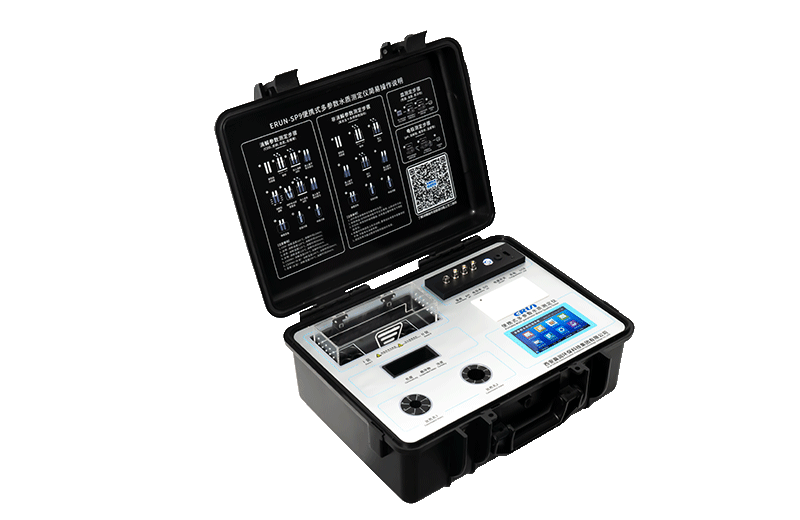Turbidity is one of the most important indicators of water quality, yet it is often overlooked outside professional water management fields. It reflects how clear or cloudy water is, revealing the presence of suspended particles such as silt, microorganisms, organic material, and industrial pollutants. High turbidity not only affects water appearance but can also signal contamination, decrease disinfection effectiveness, and indicate problems in wastewater treatment, drinking water production, and environmental monitoring.
Understanding how to measure turbidity in water is the first step in maintaining regulatory compliance and ensuring safe water for industrial, municipal, and ecological applications. Today’s turbidity monitoring relies on scientific methods and advanced digital instruments that deliver accuracy and consistency across different water types. This article explains the main turbidity measurement methods and highlights how modern multi-parameter tools like the ERUN-SP9 simplify water quality assessment.
Turbidity describes the cloudiness or haziness of water caused by suspended particles that scatter light. Higher turbidity means lower water clarity and typically indicates more contaminants. Many regulatory bodies, including the WHO and the EPA, require turbidity monitoring for drinking water, wastewater discharge, aquaculture systems, and industrial processes.
Common causes include:
Soil runoff
Organic decomposition
Microbial growth
Industrial discharge
Chemical precipitation
These particles can affect operational efficiency, public health, and environmental stability. Therefore, accurate turbidity measurement is essential for water operators, engineers, and environmental professionals.

The most widely used method measures turbidity in Nephelometric Turbidity Units (NTU). A light beam enters the water sample, and a detector measures the intensity of light scattered at a 90-degree angle.
This method is standard for:
Drinking water
Wastewater treatment plants
Environmental monitoring
A simple disk is lowered into lakes or rivers until it is no longer visible. Although not highly precise, it is effective for field estimation of water clarity in natural bodies of water.
Clear tube marked with measurements used to approximate turbidity in streams and surface water. It is inexpensive and suitable for rapid assessments.
High-end meters use infrared or multi-angle scattering to detect turbidity more accurately. These instruments offer better consistency in complex water samples containing mixed particle sizes or color interference.
Poor turbidity measurement can result in:
Misjudgment of water safety or treatment effectiveness
Regulatory non-compliance
Inefficiencies in filtration processes
Reduced accuracy in related water quality parameters
Industries such as food processing, pharmaceuticals, aquaculture, and municipal water supply depend on precise turbidity monitoring to maintain quality, consistency, and operational reliability. That’s why instrumentation choice matters.
Traditional turbidity meters measure only turbidity. But water quality issues rarely occur in isolation. Operators often need to evaluate multiple key parameters simultaneously, including pH, dissolved oxygen, salinity, conductivity, and temperature.
This is where modern multi-parameter instruments offer a significant advantage. They streamline workflows, reduce equipment requirements, and improve data accuracy.
The ERUN-SP9 is a next-generation multi-parameter water quality analyzer designed to bring precision and flexibility to professional water testing. Although its core strength is multi-parameter analysis, it also supports accurate turbidity measurement alongside other critical indicators.
Using a sophisticated optical technology platform, ERUN-SP9 ensures stable measurement across more than 60 water quality parameters, including:
Turbidity
pH
Conductivity
TDS
Salinity
Dissolved oxygen
Water temperature
This integrated system is particularly valuable in complex environments where turbidity interacts with other variables.

Operators can freely combine parameters according to their operational needs. This makes ERUN-SP9 suitable for industries with diverse water quality requirements, such as:
Municipal water supply
Environmental monitoring
Wastewater treatment
Aquaculture and fisheries
Chemical and pharmaceutical production
Thermal power plants
Biotechnology and fermentation processes
With its robust design and user-friendly interface, ERUN-SP9 enables fast, accurate turbidity measurement anywhere—from treatment facilities to remote field locations. Its versatility reduces testing time while improving reliability, making it ideal for routine monitoring and emergency assessment.
Consistent turbidity monitoring helps identify issues early, such as filter failure, microbial contamination, or increasing organic load. ERUN-SP9 supports teams in maintaining compliance with EPA, WHO, or local discharge standards by delivering real-time, precise data.
Measuring turbidity in water is fundamental for understanding water quality and maintaining safe, compliant operations. From NTU-based laboratory analysis to multi-parameter field instruments, having accurate tools ensures reliable results. The ERUN-SP9 stands out with its 16-channel optical system, multi-parameter capabilities, and adaptability across industries. For professionals seeking both accuracy and efficiency, it provides a comprehensive solution for monitoring turbidity and overall water health.